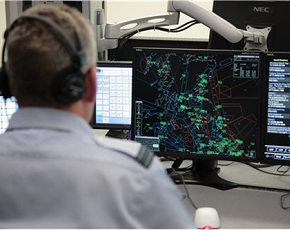UK air traffic control provider NATS has deployed a Violin Memory all-flash array solid state storage system to support a planned 6,000-seat virtualised desktop infrastructure(VDI)roll-out.
The Violin all-flash array will provide performance that would have required a traditional hard disk drive(HDD)SAN many times bigger to provide equivalent performance in input/output operations per second(IOPS),especially during so-called boot storms when users log on at the start of shifts.
NATS plans to roll out a virtual desktop environment for business applications based on Windows 7 and Office 2010.Currently,shared desktops are provided from a Citrix XenApp virtual server environment,but the organisation–which handled 2.2 million UK flights last year–plans to move to XenDesktop for VDI capability.
To support the VDI project NATS evaluated HDD SANs and all-flash arrays.HDD-based arrays were rejected on grounds of the amount of drives and physical footprint required as well as projected power,cooling and maintenance costs.
The product eventually chosen was a Violin Memory 6232 all-flash array with 20 TB capacity.The array will be used to store virtual server and desktop system information while production data will remain on existing HP and EMC SANs.
Flash module longevity
NATS'IS manager Oliver McLenaghan,said:"We went for an all-flash array based on performance and power and space savings.
"Compared to a spinning disk array,the footprint it takes up is very small–3U compared to 10U or 15U for a traditional array to give the same amount of IOPS."
McLenaghan added:"We don't require all the performance it will provide from day one,but it will scale to what we need.
"Currently it supports a XenApp environment,from which we are running shared desktops,but it will support a XenDesktop virtual desktop environment too,which we plan to move to and which has much higher IOPS requirements."
McLenaghan said the reason Violin was chosen over other all-flash array vendors was due to its claims over flash module longevity.MLC flash arrays can suffer from short module life and irregular wear patterns because they are capable of a finite number of read/write cycles during their lifetime.
Violin claims to mitigate this by striping data across flash modules using the vendor's proprietary vRAID in a 4-plus-1 parity system.This is aimed at providing predictable performance and gives the MLC flash modules a five-year endurance cycle.
The 6632 is one of two Violin 6000 series devices.It has MLC flash and is optimised for capacity but provides 500,000 IOPS.The vendor also sells the 6616,which uses SLC flash and is optimised for I/O performance to provide 1,000,000 IOPS.
Violin Memory arrays comprise Violin Intelligent Memory Modules(VIMMs),which are hot swappable,with data failing over to spares on VIMM failure.





